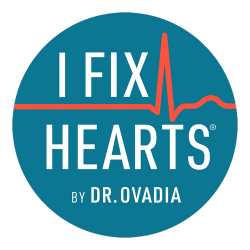Maybe you’ve just started noticing the warning signs, or maybe you’re still in shock from your recent CAC score. Either way, you’re aware that you’re combatting heart plaque and you just want to know how to make it go away.
But perhaps you’ve also heard it’s impossible to reverse plaque buildup in the heart. According to your doctor, lifelong statins are the only solution.
I’m here to tell you that is patently false.
Contrary to popular belief, you can reverse heart plaque (otherwise known as atherosclerosis).
Here’s what you need to make it happen.
How to check plaque buildup in your heart
First, a quick note on how to quantify risk.
There are a few different ways to measure plaque buildup in the heart:
- A Coronary Artery Calcium (CAC) score. This is an imaging test that measures the calcium in your arteries. The lower the score, the lower the plaque (and vice versa). You should have a score close to zero as someone under 40, and a score of less than 100 as a person over 40.
- A Coronary CT Angiogram is a more detailed look at the arteries of the heart and the plaque they might contain. While it gives more information about both calcified and non-calcified plaque, the tradeoff is a higher radiation dosage, the need for contrast to be used and more expense.
- A lipid test, sometimes also referred to as a cholesterol test. These measure three different fats present in your blood: low-density lipoprotein (LDL, or ‘bad’ cholesterol), high-density lipoprotein (HDL, or ‘good’ cholesterol), and triglycerides (fat stored as energy). Having high triglycerides and low HDL can significantly increase your risk for heart disease., whereas a high LDL level may or may not increase risk. The quality of your LDL particles is important context to understand in addition to the amount of LDL.
- An apolipoprotein B-100 test, better known as an apoB. This measures a substance in your blood that contributes to plaque blockages in your arteries. Anything at or above 110 milligrams per deciliter (mg/dL) may indicate an unhealthy ratio of LDL in the blood — but again, the quality of lipid particles is important context.
I could spend several more paragraphs on the risks of soft and hard plaque, the nuances of cholesterol, and the underlying reasons why plaque buildup is an American epidemic. But for the sake of this conversation, let’s stay focused on solutions.
Because regardless of the test, you’ll know pretty quickly if you’re in the danger zone.
What reverses heart plaque
I can’t guarantee you’ll see results overnight. But I will say lowering arterial plaque by 1% can lower your risk of heart attack and stroke by nearly 20%.
The quicker you take action, the quicker you’ll see results.
Let’s break down the science so you can get started today:
1. Regular exercise
It’s not hard to imagine that exercise is good for your heart. However, we’ve only recently measured its effects on arterial plaque.
The CENIT trial of 2022 did just that by measuring the heart plaque volume of 60 patients (averaging 58 years old). One group did nothing and served as the control group. The other underwent six months of supervised high-intensity interval training (HIIT) lasting 45 minutes twice per week.
To summarize their routine:
- There was a 10-minute warmup
- Followed by four 4-minute exercise intervals that brought participants to 85 to 95% of peak heart rate
- With a three-minute recovery period between each internal
At the end of the trial, researchers measured the participant’s percent atheroma volume (PAV) to see how much difference there was between the exercise group and the control group. Not only did they increase muscle, lose fat, and improve their lung capacity, but they shrank their PAV score by 1.2%.
That’s not to say you need HIIT exercise — there are many other options depending on your fitness level and lifestyle needs.
And if you don’t think you have enough time to exercise at all, read about four simple ways to strengthen your heart.
2. Balanced cholesterol
Cholesterol can certainly be a marker of poor heart health — but high levels alone aren’t the boogeyman we should be focused on. Case in point: around 75% of patients who have suffered a heart attack had ‘normal’ cholesterol levels based on general reference ranges.
This is because not all cholesterol is created alike. And your body needs cholesterol to function correctly (which is where statins get it wrong).
The goal should be to balance the ratio between LDL, HDL, and triglycerides, not necessarily lower total cholesterol levels.
This means focusing on:
- A total cholesterol to HDL ratio of 3.5:1
- A triglyceride to HDL ratio of 1:1 to 2:1 (when measured in mg/dL)
- Types of LDL particles (small dense versus big fluffy)
You can check all of these by ordering an advanced lipid study with particle sizes.
To summarize, the better controlled your cholesterol ratios are, the lower your risks for arterial plaque buildup will be, and the faster you can shrink existing buildup.
But making a difference takes work without statins. You can do this by following the seven principles of better metabolic health.
3. Control inflammation
When your body becomes injured, it becomes inflamed to protect itself. This isn’t necessarily a bad thing in short bursts — but over time, can result in a trickle-down effect of more inflammation, higher cholesterol, and faster-growing plaque.
There are several different ways to control inflammation in the body:
- Avoid added sugar, processed grains like flour and rice, and seed oils like soybean, canola, or vegetable blends
- Focus on getting more sleep (at least seven hours)
- Find ways to healthily manage stress
Some people find that supplementation can help with high markers of inflammation. Vitamin K, for example, can block inflammatory cells. There’s also evidence from the AVADEC Trial of 2023 suggesting it can help avoid calcium plaque buildup. Just be sure to aim for quality if you take this route — not all metabolic health supplements are the same.
Another option is prescription medication, including a food cholesterol blocker like Ezetimibe. This is a non-statin and doesn’t display the same side effects or risk factors. It can also drop PAV by as much as 1.3%.
But as always, I believe that medication isn’t always the best treatment for chronic disease.
How to stop heart plaque from progressing
Now that you’re making progress on existing plaque, here’s how to prevent more from building up:
Cut sugar from your diet
High sugar consumption is directly associated with expedited plaque buildup, especially sugar-sweetened beverages like soda, iced tea, or fruit juice.
Of course, I realize ‘cutting sugar’ can mean many things to many different people. At the end of the day, the goal should be un-sweetening your meals and avoiding artificial sweeteners that could negatively affect your heart.
If you want my opinion, you should avoid:
- Highly processed sugars like cane or corn syrup
- Fake sugars like Sweet N’ Low or aspartame
- Added sugar in any dish, especially ‘health’ foods
The easiest way to do this is to cook at home or read the ingredients label for anything packaged.
Quit smoking
Smoking isn’t good for people in general, so I won’t belabor the point. But to summarize, quitting cigarettes can dramatically lower inflammation, fight arterial constriction, and prevent LDL from oxidizing in the bloodstream.
If you don’t feel ready to quit on your own, it may be worthwhile to ask for support.
Adopt a low-carb diet
Dietary changes won’t instantly reverse plaque buildup, but they can make it easier to keep lower levels in the future.
Low-carb diets can be powerful tools for controlling heart plaque because they address the root cause of the problem: insulin resistance. Just keep in mind that keto is only one of many methods available. You could always opt for a carnivore diet, ketovore, or something in between.
The rule of thumb for reversing atherosclerosis
Truth be told, there’s no magic formula. And as cliche as it sounds, it requires lifestyle changes.
Exercise often. Eat whole, real foods. If absolutely necessary, look at non-statins medications and supplements.
The rule of thumb here is daily consistency. There’s no better way to make progress than to put one foot in front of the other.
If you can start applying these action steps for at least six months, I guarantee you’ll see results in your next blood test.
But if you haven’t yet benchmarked your metabolic health, you can do so today with my free metabolic syndrome calculator.
Looking for the highest-quality meat from farmers who share your values?
I’m proud to partner with Route 22 Meats, where we connect health-conscious families with clean, sustainably raised meat from small family farms.
Your support doesn’t just bring premium cuts to your table. It helps empower local farmers, promote regenerative agriculture, and support a grassroots mission to improve food quality—and health—for all.
Explore our selection and experience the difference today.

